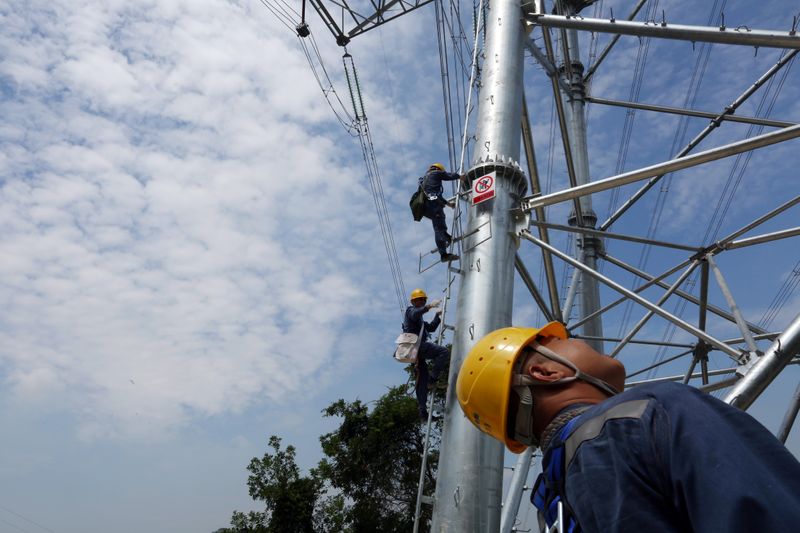By Tom Daly and Min Zhang
(Reuters) - Metal consumers in China, from appliance makers to auto, construction and solar panel firms, are readying themselves to face potential supply shocks after power curbs and shortages forced several smelters to cut production in recent weeks.
Output curbs tied to emissions caps over the winter are nothing new to China's steel and aluminum makers. This year, though, power constraints dragged on through summer because of low coal supplies and strong demand, leading to forced shutdowns of energy-intensive operations and worries about sufficient heating as cooler weather approaches.
Power-hungry sectors like aluminium and cement were also always likely to be first in line when Chinese regions were told to redouble their efforts earlier this year to meet lower energy consumption and intensity targets.
China power rationing map https://graphics.reuters.com/CHINA-POWER/jnvweyzazvw/chart.png
Fertiliser producers, also notorious energy hogs, have been affected by power cuts and surging costs as well, but because of their importance to food security they have been allowed to maintain high operating rates and assured of power supplies.
NO REPRIEVE
Many metal makers, however, have been ordered to reduce operations to conserve power, resulting in lost output of key industrial materials.
Much of China's metal production is concentrated in regions with severe power restrictions in place, including Jiangsu, Hebei, Xinjiang and Yunnan, as soaring electricity demand outstrips supply and forces the government to take drastic action to try and contain the fallout.
China's top producers of key industrial products & commodities https://fingfx.thomsonreuters.com/gfx/ce/zgpombendpd/ChinaProvinceProducersCommods.png
Investment bank Morgan Stanley (NYSE:MS) estimates 7% of aluminium capacity in China has so far been impacted by power curbs, while roughly 67% of China's total steel capacity across 11 provinces have announced some output controls for the second half of 2021.
For cement, 35% of China's total production has been impacted, and around 30%-40% of major petrochemical production capacity, it said.
China will churn out roughly 1.5 million tonnes of aluminium less than planned this year, which means lost metal sales of $4.5 billion, said BMO Capital Markets analyst Colin Hamilton, adding that the figure for steel is likely much higher.
Some of the biggest commodity price spikes this year have been in steelmaking materials such as ferrosilicon and silicomanganese, which have shot up 87% and 58% this quarter alone, respectively, as power curbs forced output cuts.
China’s coal and metal prices surge amid power crunch, forced output curtailments https://fingfx.thomsonreuters.com/gfx/ce/akvezqrowpr/ChinaCoalMetalPrices.png
"Power controls are the talk of the marketplace," said Clare Hanna, senior steel analyst at CRU, who estimates China's silicomanganese production plunged 40% in July from the previous month as curbs that began in Inner Mongolia spread to Guangxi and elsewhere.
"We are anticipating that power supply is going to be quite tight through the winter," Hanna said.
Power curbs on aluminium also began in Inner Mongolia before spreading to Yunnan in China's southwest. Over the past three years, aluminium smelters have moved capacity to the province, which is also a major tin and zinc hub, to tap its usually abundant hydropower resources, but severe drought in May and June this year strained the grid.
China seasonal metals output https://fingfx.thomsonreuters.com/gfx/ce/byvrjldqyve/ChinaSeasonalMetalsOutput.png
Chinese aluminium companies had been looking to tap into the trend towards low-carbon aluminium, said Paul Adkins, managing director of consultancy AZ China.
But "there's simply not enough renewable energy to support any more than 20% of the total need," he said.
COSTLY CUTS
Smelters also face a costly dash to secure enough coal for their captive power plants, with Chinese thermal coal futures near record highs above 1,300 yuan ($200) a tonne.
China thermal coal prices https://fingfx.thomsonreuters.com/gfx/ce/gdpzyqjlwvw/ChinaThermalCoalSep272021.png
Dozens of manufacturers ranging from dye makers to soybean crushing plants have also had to curtail or stop operations at least through the end of the upcoming National Day holiday from Oct. 1, although some market watchers expect the curbs to last longer.
"China’s power shortages are a reflection of the global strain in energy markets and won’t be resolved overnight," Capital Economics said in a note to clients on Wednesday.
"Power rationing will constrain industrial activity until demand weakens enough to bring the domestic electricity market back into equilibrium."
Extended metal supply outages pose a risk to an array of end users, who are already facing rising prices.
"A key concern for the auto supply chain is the cost-push inflation and tightening upstream supply that could affect downstream production/profits," said Morgan Stanley.
China seasonal output of industrial goods https://fingfx.thomsonreuters.com/gfx/ce/lbvgngdlkpq/ChinaseasonalOutputIndustrialgoods.png
($1 = 6.4662 yuan)
